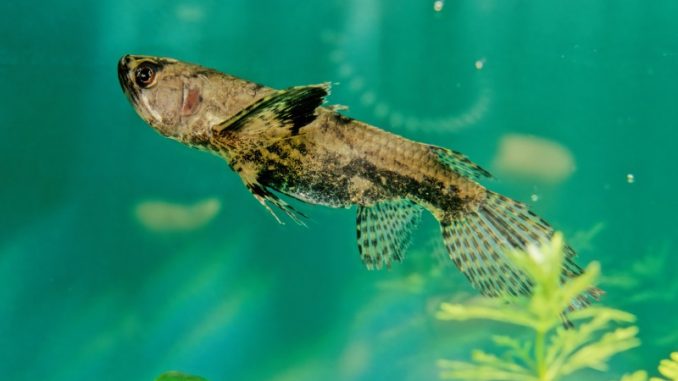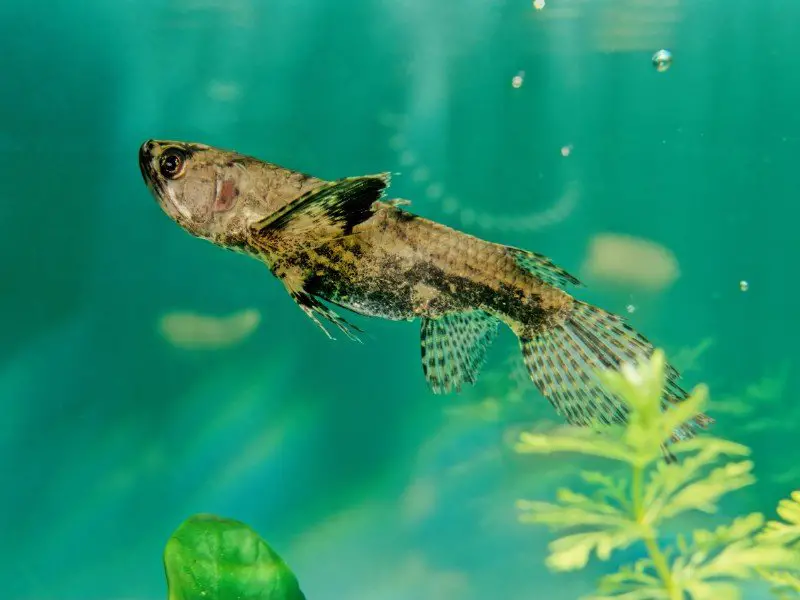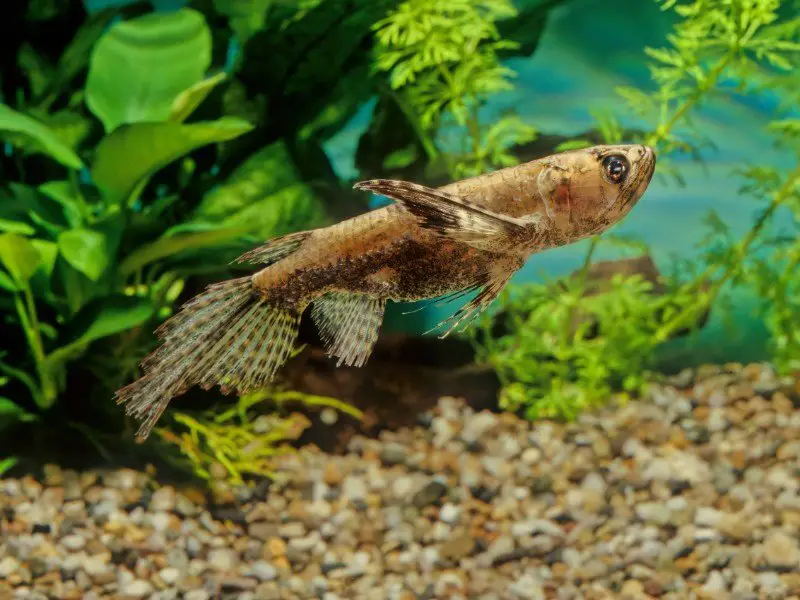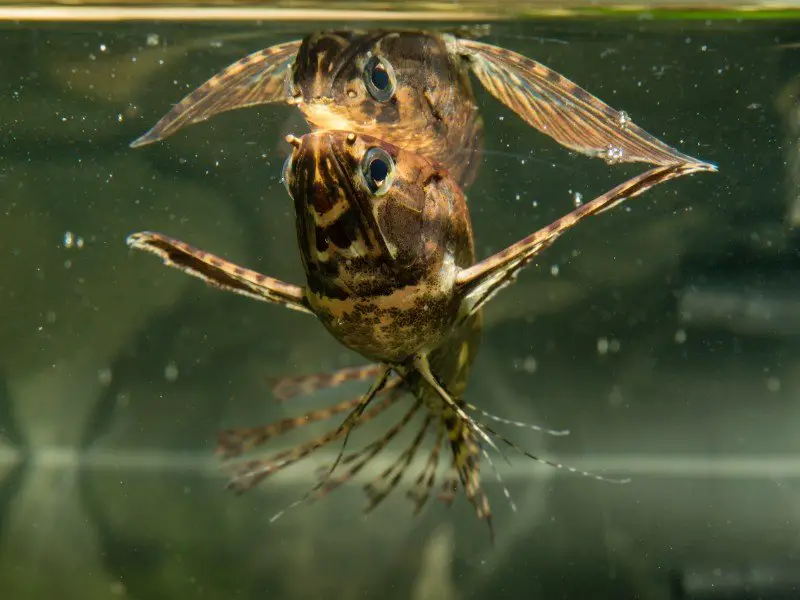
The African butterflyfish is a freshwater fish of the Pantodontidae family and is the only member of the family and species. These surface-residing fish vary in color, ranging from brown to green to gray. The air-breathing, triple-jawed fish are commonly referred to as living fossils because the fish have remained unchanged for millions of years. African butterflyfish have recently gained popularity with aquarists because of the fish’s unique appearance.
TABLE OF CONTENTS
African Butterflyfish Facts & Overview

| Scientific name | Pantodon buchholzi |
| Common names | African butterflyfish, freshwater butterfly fish |
| Distribution | West Africa |
| Size | 4–5 inches long |
| Life expectancy | 5–6 years |
| Color | Brown, gray, or green mottled pattern |
| Diet | Insectivore |
| Temperament | Semi aggressive |
| Minimum tank size | 40 gallons |
| Temperature: | 75–86°F (23–28°C) |
| pH | 6.5–7.0 |
| Hardness | 8–12 dGH |
| Care level | Advanced |
| Breeding | Egg scatterer |
Origin
The African butterflyfish is naturally occurring in still, shallow lake water in West Africa. These fish are commonly found in the Congo Basin, Cameroon, Ogooue, Lake Chad, and the Lower Niger and Upper Zambezi rivers. Smaller populations of these fish can be found in the Lower Ogun, Niger Delta, and Lower Cross rivers.
Adult Size & Lifespan
In the wild, African butterflyfish grow up to 5 inches long. In captivity, these fish are smaller, with an average length of 4 inches. The average lifespan of this fish is five years but, with proper care, aquarists can extend fish lifespans up to 10 years.
Female African butterflyfish grow longer and heavier than males and have a broad unbroken anal fin. The male fish’s anal fin is separated into two sections with the lower segment being longer than the upper portion of the fin.
Availability
The African butterflyfish is readily available in most pet stores. The fish cost from $10 to $25 each — generally more expensive than other freshwater fish. The species can be purchased online at Aqua-Imports, Royalty Aquatic and Pets, and LiveAquaria.
Appearance & Behavior
African butterflyfish are primarily sedentary and inhabit the top sections of aquariums. This behavior aids the fish in hunting for food. These fish have deep bodies that are flat on the top. The pectoral fin’s winged shape gives the butterflyfish its name.
Colors, Patterns, Fins, and Sex Differences
African butterflyfish are brown, gray, or green with a spotted pattern that helps them blend in with plant life.
When viewed from above, the broad pectoral fins look like a butterfly. The pectoral fins are decorative, similar to a butterfly’s wings, and allow the fish to jump out of the water to catch prey. African butterflyfish have large caudal fins and average-sized anal and dorsal fins. The caudal, anal, and dorsal fins are all slightly translucent with evenly spaced dark lines.
The butterflyfish are predators and their structure supports their surface-dwelling hunting behavior. Their eyes and mouths angle upwards, which helps these fish see and capture prey.
Males have segmented anal fins with a small upper region and a large, lower convex section. The female fish have singular anal fins with a straight lower edge.
Typical Behavior
African butterflyfish are mostly motionless unless they’re hunting. The fish swiftly capture their prey and then dart away to eat it. These butterflyfish are fast swimmers when necessary. When they are not hunting, the fish stay motionless below the surface of the water, hidden by floating plant life.
Butterflyfish are territorial and will fight other fish that invade their space. This species must be paired with similar-sized fish because butterflyfish will eat smaller fish.
African Butterflyfish Care & Tank Requirements

African butterflyfish are difficult to care for because they need special care and have temperamental behaviors.
Naturally carnivorous, this species thrives when fed a diet of live insects multiple times per day. The fish can be fed roaches, spiders, flies, and earthworms. Grasshoppers are also preferred.
Habitat and Tank Requirements
Freshwater African butterflyfish need soft or slightly acidic water. A long, wide, shallow aquarium with ample surface area and floating plant life provides the most suitable habitat for these predator fish.
The fish wait near the surface for prey, and floating plant life provides the fish with needed protection while the butterflyfish hunts. African butterflyfish require a lidded tank because the fish are excellent jumpers.
Tank Conditions
The African butterflyfish should be housed in a 40-gallon shallow tank filled with slightly acidic water and floating plants.
- Water type: Soft, slightly acidic
- Tank size: Minimum 40 gallons (151 liters)
- Water temperature: 75–86ºF (23–28°C)
- Substrate: Any
- Tank setup: Plants
- Acidity: 6.5–7.0 pH
- Water hardness: 8–12 dGH
- Filter: Yes, at the bottom of the tank over the substrate
- Bubbler: No
African butterflyfish require a powerful tank filter that’s capable of keeping the tank water clean without creating water movement. The filter should be at the bottom of the tank to ensure it won’t bother the butterflyfish. Changing 20% of the water weekly is recommended.
Disease
African butterflyfish are susceptible to bacterial infections, skin flukes, parasitic infestations, ichthyobodo infection, and bacterial diseases. This species is hardy and doesn’t succumb to diseases in a well-maintained habitat.
Thoroughly clean new tank elements — fish, plants, substrate, and decorations — before adding them to the butterflyfish’s tank to avoid introducing diseases and disturbing the ecosystem. Quarantining additions before adding them to the tank is another way to discourage disease in the aquarium. If an outbreak is diagnosed early, the number of fish infected can be limited because of this species’ resilience.
Stress is a common cause of sickness. If the fish are uncomfortable in their habitat, they are more likely to develop diseases over time. To avoid stress, keep the shallow tank clean with soft, slightly acidic, motionless water, bottom-dwelling tankmates, and floating plant life.
Tank Mates
The African butterflyfish is a good tank mate for fish that swim in the bottom or middle of the aquarium. This fish can be aggressive to small fish and fish that swim at surface level. Fin-nipping fish create a stressful environment for the butterflyfish.
Although butterflyfish occasionally eat crustaceans in the wild, the two species often coexist in captivity because they inhabit opposite parts of the aquarium.
Great tank mates for African butterflyfish include:
- Elephant nose fish
- Catfish
- Knife fish
- West African cichlid (medium-sized)
- Rope fish
- Bristlenose and rubber lip plecos
- Kuhli loach
- Congo tetra
Diet and Feeding
African butterflyfish are naturally carnivorous and feed on a diet of aquatic insects, aquatic larvae, and insect nymphs. The best diet for this fish in captivity is one that mimics the butterflyfish’s diet in nature.
Feed your African butterflyfish a protein-rich diet two to four times per day of live insects and feeder fish that float on the surface. Avoid pellets and flakes. Hold food at surface level with forceps to feed the butterflyfish if the food doesn’t float.
Breeding
African butterflyfish are difficult to breed. Lower the water level to 6–8 inches, feed the pair live foods, and reduce the water temperature in the tank to encourage spawning.
Once spawning begins, the female will produce three to seven eggs in each mating pass, and the white eggs will immediately float to the surface. The pair can produce more than 100 eggs a day.
After spawning, immediately remove the eggs from the tank so the parents don’t eat the eggs. The eggs darken over the first 24 hours and will hatch within the week.
Baby butterflyfish have underdeveloped fins and don’t eat unless food is directly in front of their mouths. Older and larger butterflyfish eat smaller weaker siblings, and this can dramatically reduce the number of fry.
Feed African butterflyfish fry brine shrimp and daphnia. Frequently remove uneaten food that falls to the bottom of the tank to ensure the fry’s health doesn’t deteriorate.
Should You Get an African Butterflyfish for Your Aquarium?

African butterflyfish are challenging freshwater fish to care for and the species requires a specific habitat to thrive.
If your tank doesn’t include small fin-nipping fish that dwell near the surface, the African butterflyfish will make a great addition to your tank. These fish make stunning aquarium additions that put on a show by jumping out of the water and gliding through the air.

Be the first to comment